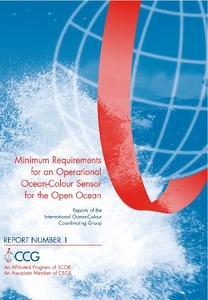| dc.contributor.editor | Morel, André | |
| dc.coverage.spatial | Global | en_US |
| dc.date.accessioned | 2018-09-21T12:57:26Z | |
| dc.date.available | 2018-09-21T12:57:26Z | |
| dc.date.issued | 1998 | |
| dc.identifier.citation | IOCCG (1998) Minimum Requirements for an Operational, Ocean-Colour Sensor for the Open Ocean, (ed. A. Morel). Dartmouth, NS, Canada, International Ocean-Colour Coordinating Group (IOCCG), 46pp. (Reports of the International Ocean-Colour Coordinating Group, No. 1), DOI: http://dx.doi.org/10.25607/OBP-93 | en_US |
| dc.identifier.uri | http://hdl.handle.net/11329/513 | |
| dc.identifier.uri | http://dx.doi.org/10.25607/OBP-93 | |
| dc.description.abstract | With the advent of increasingly-sophisticated satellite ocean-colour sensors in the late 1990’s, with better radiometric performances and in increased number of spectral channels, an IOCCG working group was formed to determine whether it is possible to satisfy the requirements for an operational ocean-colour mission at low cost based on simple sensors? In particular, can useful information be provided if the sensor is operated with a reduced number of spectral channels? If such a minimal set of bands could be identified, a corollary would be to recommend it for inclusion in all sensors, regardless of their other capabilities and of the larger number of channels they may possess. A commonality in the spectral acquisition provides important practical, as well as scientific, advantages. Indeed, it would allow: easy intercomparison between sensors, and even radiometric intercalibration in well-defined conditions; a full compatibility of operational algorithms for atmospheric correction and derivation of end products; a meaningful data merging, at the level of geophysical products (pigment index, aerosol optical thickness) or at the level of the initial quantities (e.g., spectral normalized radiances); a long-term continuity of ocean-colour observations, based on stable, entirely comparable, parameters; and therefore the building up of a coherent data base for biogeochemical studies and related modeling activities, for physical studies and models (heating rate, mixed layer dynamics), and for climatological purposes involving the radiative budget and the effect of aerosol loading. The deployment of such simple sensors is in no way contradictory to the conception, development and use of more sophisticated instruments, designed for advanced research purposes. Indeed, several sensors will be in simultaneous operation in the near future, with differing capabilities, some complementarity, and a partial planned redundancy. | en_US |
| dc.description.sponsorship | IOCCG Sponsoring Space Agencies | en_US |
| dc.language.iso | en | en_US |
| dc.publisher | International Ocean Colour Coordinating Group (IOCCG) | en_US |
| dc.relation.ispartofseries | Reports of the International Ocean Colour Coordinating Group;1 | |
| dc.rights | Attribution-NonCommercial-NoDerivs 4.0 | * |
| dc.rights.uri | http://creativecommons.org/licenses/by-nc-nd/4.0/ | * |
| dc.subject.other | IOCCG | en_US |
| dc.title | Minimum Requirements for an Operational, Ocean-Colour Sensor for the Open Ocean. | en_US |
| dc.type | Report | en_US |
| dc.description.status | Published | en_US |
| dc.format.pages | 46pp. | en_US |
| dc.contributor.corpauthor | IOCCG | |
| dc.description.refereed | Refereed | en_US |
| dc.publisher.place | Dartmouth,NS, Canada | en_US |
| dc.subject.parameterDiscipline | Parameter Discipline::Biological oceanography | en_US |
| dc.subject.instrumentType | Instrument Type Vocabulary::ocean colour radiometers | en_US |
| dc.subject.dmProcesses | Data Management Practices::Data acquisition | en_US |
| dc.description.currentstatus | Current | en_US |
| dc.description.eov | ocean colour | en_US |
| dc.description.bptype | Best Practice | en_US |
| obps.contact.contactemail | vstuart@ioccg.org | |
| obps.resourceurl.publisher | http://ioccg.org/wp-content/uploads/2015/10/ioccg-report-01.pdf | en_US |
 Repository of community practices in Ocean Research, Applications and Data/Information Management
Repository of community practices in Ocean Research, Applications and Data/Information Management

